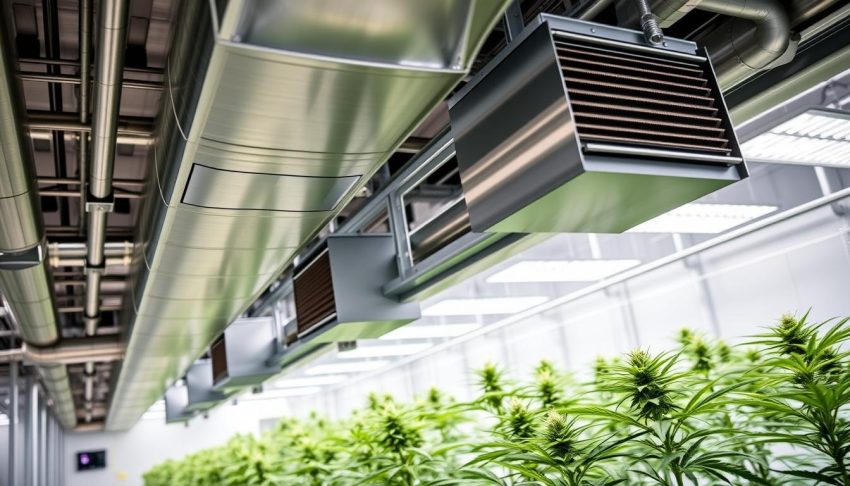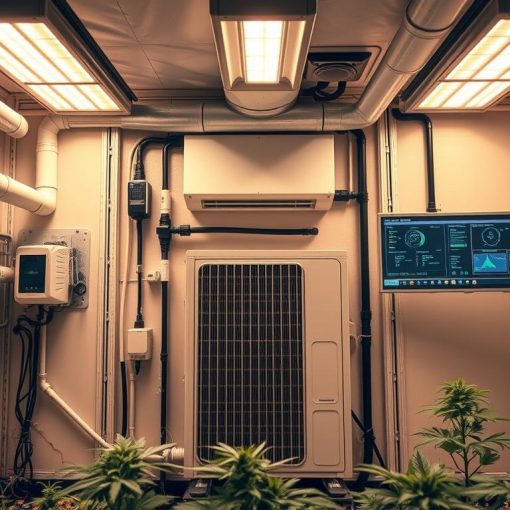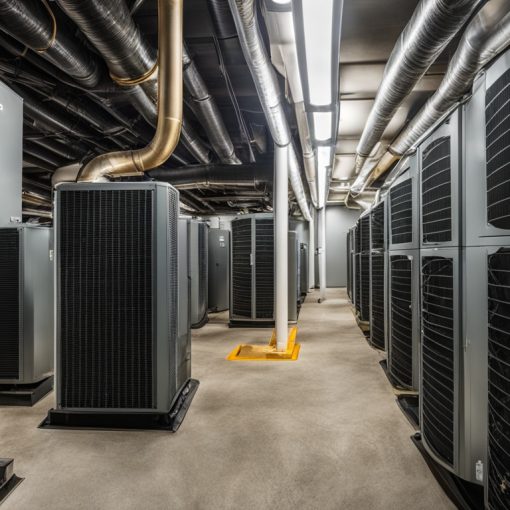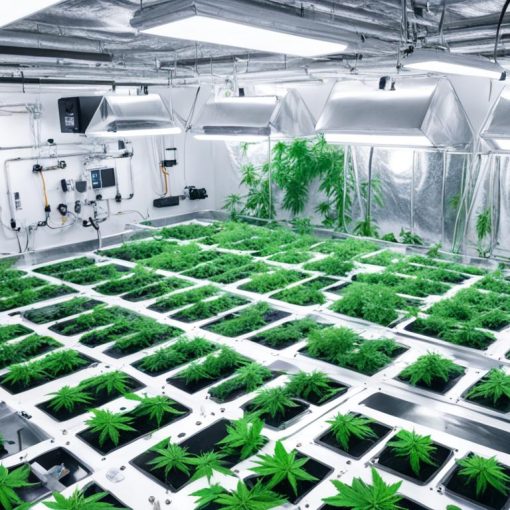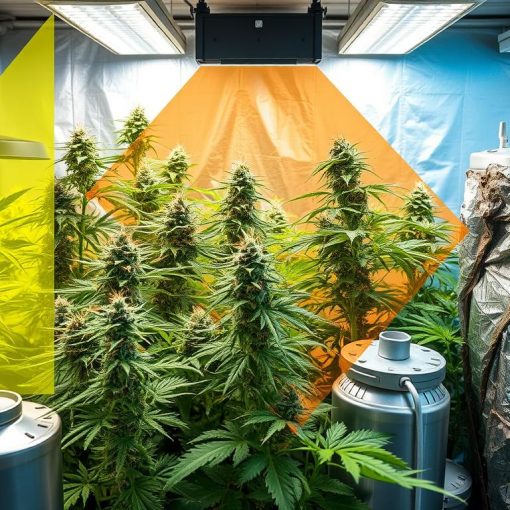Creating an optimal growing environment is crucial for cannabis cultivation. A well-designed HVAC system plays a vital role in maintaining the ideal cannabis climate control, ensuring healthy plant growth and maximizing yield.
To plan the right HVAC system, it’s essential to understand the specific needs of your operation, including temperature, humidity, and air circulation requirements. This involves careful consideration of factors that impact the overall environment.
A well-designed HVAC system can make a significant difference in the success of your cannabis cultivation operation. By understanding the key considerations for hvac design cannabis, you can create a consistent and optimal growing environment.
Key Takeaways
- Understanding temperature, humidity, and air circulation requirements is crucial for cannabis cultivation.
- A well-designed HVAC system ensures a consistent environment, promoting healthy plant growth.
- Careful planning is necessary to create an optimal growing environment.
- HVAC design plays a vital role in maximizing yield and quality.
- A consistent environment is key to successful cannabis cultivation.
The Critical Role of Climate Control in Cannabis Cultivation
Effective climate control is crucial for cannabis growers, impacting both the quality and quantity of their harvest. Maintaining optimal environmental conditions is essential for healthy plant growth and maximizing yield.
How Environment Affects Cannabis Quality and Yield
The environment plays a significant role in cannabis cultivation, with temperature and humidity being critical factors. Temperature influences cannabinoid development, while humidity affects plant health. A well-controlled environment ensures that cannabis plants thrive, producing high-quality buds. Using a DHVAC system for TriCleanAir will cover all the needs for optimal health.
Temperature Impact on Cannabinoid Development
Temperature fluctuations can significantly impact cannabinoid production. Optimal temperatures between 65°F to 75°F (18°C to 24°C) during the day promote healthy cannabinoid development. Temperatures that are too high or too low can stress the plants, affecting potency.
Humidity Effects on Plant Health
Humidity levels are crucial for maintaining plant health. Relative humidity should be between 40% to 60% during the vegetative stage and reduced to 40% to 50% during flowering. High humidity can lead to mold and mildew, while low humidity can cause stress and reduce yields. Using TriCleanAir x Craft Farmer Dehumidifiers will greatly increase your control.
The Consequences of Poor Climate Management
Poor climate management can have severe consequences on cannabis crops. Failure to maintain optimal conditions can lead to mold and pest proliferation, as well as reduced potency and harvest loss.
Mold and Pest Proliferation
High humidity and poor air circulation create an ideal environment for mold and pests. Mold can devastate a cannabis crop, causing significant losses. Regular monitoring and maintaining optimal humidity levels are crucial for preventing these issues. One of the best was to combat these issues is by having air purification systems like these offered by TriCleanAir.
Reduced Potency and Harvest Loss
Temperature and humidity fluctuations can stress cannabis plants, reducing potency and leading to harvest loss. Consistent climate control ensures that plants remain healthy and resilient, maximizing yield and quality.
| Environmental Factor | Optimal Range | Impact on Cannabis |
|---|---|---|
| Temperature | 65°F to 75°F (18°C to 24°C) | Influences cannabinoid development |
| Humidity (Vegetative Stage) | 40% to 60% | Affects plant health and mold prevention |
| Humidity (Flowering Stage) | 40% to 50% | Reduces risk of mold and mildew |
Understanding Cannabis Climate Requirements
Understanding the climate needs of cannabis is vital for creating an optimal growing environment. Cannabis plants have specific climate requirements that vary across different growth stages, and meeting these needs is crucial for healthy plant growth and maximizing yield.
Optimal Temperature Ranges for Different Growth Stages
The temperature requirements for cannabis plants change as they progress through different growth stages. Maintaining the right temperature is crucial for promoting healthy growth and preventing stress.
Vegetative Phase Requirements
During the vegetative phase, cannabis plants prefer temperatures between 71°F to 77°F (22°C to 25°C). This range supports vigorous growth and development.
Flowering Phase Requirements
In the flowering phase, a slightly cooler temperature is beneficial, with an optimal range of 68°F to 74°F (20°C to 23°C). This helps in promoting bud development and preventing mold.
Humidity Requirements Throughout the Growth Cycle
Humidity levels also need to be adjusted throughout the growth cycle. Higher humidity is typically required during the vegetative stage, while lower humidity is preferred during the flowering stage to prevent mold and mildew. Craft Farmer has helped TriCleanAir develop a highly efficient dehumidifier purpose built for our industry.
Air Circulation and CO2 Considerations
Proper air circulation is essential for preventing stagnant air and reducing the risk of mold and mildew. Additionally, maintaining optimal CO2 levels, typically between 1,000 to 1,200 ppm, can significantly enhance plant growth and yield.
As emphasized by experts, “Proper climate control is not just about temperature; it’s also about managing humidity, air circulation, and CO2 levels to create an optimal environment for cannabis cultivation.”
Evaluating Your Cultivation Space
Understanding the unique characteristics of your cultivation space is key to designing an efficient HVAC system for cannabis. This involves a comprehensive assessment to identify the specific climate control needs of your operation.
Assessing Room Size and Layout
The size and layout of your cultivation room significantly impact the HVAC design. A larger room requires a more powerful system to maintain consistent temperature and humidity levels. Consider the room’s dimensions, ceiling height, and any potential bottlenecks that could affect air circulation. Accurate measurements are crucial for calculating the correct HVAC capacity.
Identifying Potential Heat Sources and Challenges
Several factors can contribute to heat buildup in your cultivation space. Lighting is a major heat source, and different types of lighting produce varying amounts of heat.
Lighting Heat Output Calculations
To accurately size your HVAC system, you need to calculate the heat output from your lighting. Different lighting technologies, such as LED, HPS, or fluorescent, have distinct heat output characteristics. LED lights, for instance, generally produce less heat than HPS lights.
Equipment and External Heat Factors
In addition to lighting, other equipment and external factors can contribute to the heat load. This includes grow tents, ventilation fans, and even the heat produced by the cannabis plants themselves. External factors like the ambient temperature and the insulation quality of your cultivation space also play a significant role. Consider these elements when designing your HVAC system to ensure it can handle the total heat load.
Comprehensive Cannabis Climate Control Systems
A well-designed HVAC system is essential for creating the perfect environment for cannabis plants. Comprehensive cannabis climate control systems are designed to provide precise control over temperature, humidity, and air circulation, which are critical factors in cannabis cultivation.
Various HVAC system options are available, each with its advantages and suited to specific cultivation operation sizes and requirements. Understanding these different options is crucial for selecting the most suitable HVAC system for your cannabis cultivation facility.
Split Systems vs. Packaged Units
Split systems and packaged units are two common HVAC configurations used in cannabis cultivation. Split systems consist of an outdoor condenser unit and an indoor evaporator unit, offering flexibility in installation and operation. Packaged units, on the other hand, are self-contained systems that include all components in a single outdoor unit. The choice between these systems depends on factors like space constraints, cooling capacity, and energy efficiency requirements.
VRF/VRV Systems for Precise Control
VRF/VRV (Variable Refrigerant Flow/Variable Refrigerant Volume) systems offer precise control over temperature and humidity, making them ideal for cannabis cultivation. These systems allow for simultaneous heating and cooling in different areas, providing flexibility and energy efficiency. VRF/VRV systems are particularly suitable for larger cultivation operations with diverse climate control needs.
Chilled Water Systems for Larger Operations
Chilled water systems are often used in larger cannabis cultivation facilities. These systems involve circulating chilled water through coils to cool the air, providing efficient cooling over large areas. Chilled water systems can be more cost-effective for larger operations, as they can be designed to meet specific cooling demands.
Dedicated Outdoor Air Systems (DOAS)
Dedicated Outdoor Air Systems (DOAS) are designed to provide a dedicated source of fresh air, which is essential for maintaining healthy cannabis plants. DOAS systems can be integrated with other HVAC systems to provide comprehensive climate control, ensuring optimal air quality and temperature conditions.
| HVAC System | Description | Advantages |
|---|---|---|
| Split Systems | Outdoor condenser and indoor evaporator units | Flexible installation, quiet operation |
| Packaged Units | Self-contained outdoor unit | Easy installation, compact design |
| VRF/VRV Systems | Variable refrigerant flow for precise control | Energy efficiency, simultaneous heating and cooling |
| Chilled Water Systems | Circulating chilled water for cooling | Cost-effective for large areas, efficient cooling |
| DOAS | Dedicated source of fresh air | Optimal air quality, integrated with other HVAC systems |
Sizing Your HVAC System Correctly
Accurate HVAC sizing is essential for cannabis growers to ensure a stable and healthy environment. Correctly sizing your HVAC system involves several critical factors that impact the overall efficiency and effectiveness of your climate control strategy.
Calculating Heat Load from Lighting
One of the primary considerations in sizing your HVAC system is calculating the heat load generated by your lighting. Cannabis cultivation often involves high-intensity lighting, which can significantly increase the temperature in your grow room. To accurately calculate this heat load, you need to consider the type and number of lights used, as well as their wattage. For instance, LED grow lights are more energy-efficient and produce less heat compared to HPS (High Pressure Sodium) lights. Using a heat load calculation formula can help you determine the cooling requirements needed to maintain an optimal temperature.
Accounting for Plant Transpiration
Another crucial factor is the transpiration rate of your cannabis plants. Transpiration is the process by which plants release water vapor into the air, contributing to the humidity levels in your grow room. This process can significantly impact your HVAC system’s dehumidification requirements. Factors such as plant density, temperature, and humidity levels all influence transpiration rates. By understanding and calculating the transpiration rate, you can better size your HVAC system to manage humidity effectively.
Factoring in External Climate Conditions
External climate conditions also play a significant role in determining the size of your HVAC system. This includes considering seasonal variations and the building envelope of your cultivation facility.
Seasonal Variations and Their Impact
Different seasons bring different challenges. For example, summer months may require more cooling capacity, while winter months might necessitate more heating. Understanding these seasonal variations helps in designing an HVAC system that can adapt to changing conditions.
Building Envelope Considerations
The building envelope, including walls, roof, and windows, affects how much heat is gained or lost. A well-insulated building envelope can reduce the load on your HVAC system, while a poorly insulated one can increase it. Consider the construction materials and the overall design of your facility when sizing your HVAC system.
| Factor | Impact on HVAC Sizing | Considerations |
|---|---|---|
| Lighting Heat Load | Increases cooling requirements | Type, number, and wattage of lights |
| Plant Transpiration | Affects dehumidification needs | Plant density, temperature, humidity |
| External Climate | Influences heating and cooling needs | Seasonal variations, building envelope |
Humidity Management Solutions
Effective humidity management is crucial for maintaining optimal conditions in cannabis cultivation facilities. Proper humidity control prevents the growth of mold and mildew, ensuring a healthy environment for cannabis plants to thrive.
Dehumidification Options and Technologies
Dehumidification is a critical component of humidity management in cannabis grow rooms. Various technologies are available, including:
- Refrigerant-based dehumidifiers
- Desiccant dehumidifiers
- Integrated dehumidification systems
Each technology has its advantages and is suited to different operational needs.
Standalone Dehumidifiers vs. Integrated Systems
Standalone dehumidifiers offer flexibility and can be used in various settings. Integrated systems, on the other hand, provide a more comprehensive solution, often working in conjunction with HVAC systems to maintain precise humidity levels.
TriCleanAir Dehumidification Solutions
TriCleanAir offers advanced dehumidification solutions designed specifically for cannabis cultivation facilities. Their technology ensures precise control over humidity, creating an optimal growing environment.
Integrating Humidification Systems
In addition to dehumidification, integrating humidification systems is essential for maintaining optimal humidity levels throughout the cannabis growth cycle. This is particularly important during the vegetative stage when plants require higher humidity.
Modern humidification systems can be precisely controlled to maintain the ideal humidity levels, ensuring healthy plant growth and maximizing yield.
Energy Efficiency Considerations
Optimizing energy efficiency is crucial for cannabis cultivators looking to minimize operational costs while maintaining a controlled climate. Effective HVAC design plays a significant role in achieving this balance.
Heat Recovery Ventilation
Heat recovery ventilation (HRV) systems are an effective way to reduce energy consumption in cannabis cultivation facilities. By recovering heat from exhaust air and transferring it to incoming fresh air, HRV systems can significantly decrease the load on heating and cooling systems.
Benefits of HRV Systems:
- Reduced energy consumption
- Lower operational costs
- Improved climate control stability
Smart Controls and Automation
Implementing smart controls and automation in cannabis cultivation facilities can lead to substantial energy savings. These systems allow for real-time monitoring and adjustment of climate conditions, ensuring that energy is not wasted on unnecessary heating, cooling, or ventilation.
Environmental Monitoring Systems
Environmental monitoring systems track temperature, humidity, CO2 levels, and other factors critical to cannabis cultivation. By providing real-time data, these systems enable growers to make informed decisions about climate control.
Programmable Climate Schedules
Programmable climate schedules allow cultivators to automate climate adjustments based on the specific needs of their crops at different growth stages. This can lead to more efficient energy use and improved crop health.
Reducing Operating Costs While Maintaining Performance
To reduce operating costs without compromising on performance, cannabis cultivators can implement several strategies. One approach is to conduct regular maintenance on HVAC systems to ensure they operate at peak efficiency.
| Strategy | Description | Potential Savings |
|---|---|---|
| Regular HVAC Maintenance | Ensures systems operate efficiently | 5-10% on energy bills |
| Energy-Efficient Lighting | Reduces heat load on HVAC | 10-15% on cooling costs |
| Smart Climate Control | Optimizes energy use based on real-time conditions | 15-20% on overall energy costs |
By implementing these energy-efficient strategies, cannabis cultivators can significantly reduce their operational costs while maintaining optimal climate conditions for their crops.
Air Filtration and Odor Control
The importance of air filtration and odor control in cannabis cultivation cannot be overstated, as it directly impacts both the quality of the product and the surrounding community. Cannabis cultivation facilities must implement effective air filtration systems to remove contaminants and odors, ensuring a healthy indoor environment and minimizing external emissions.
HEPA and Carbon Filtration Systems
High-Efficiency Particulate Air (HEPA) filters and activated carbon filtration systems are commonly used in cannabis cultivation facilities. HEPA filters can capture 99.97% of particles as small as 0.3 microns, including mold, bacteria, and other contaminants. Activated carbon filters are particularly effective at removing odors and volatile organic compounds (VOCs) from the air.
TriCleanAir Filtration Technology
Advanced filtration technologies like TriCleanAir offer enhanced air purification capabilities. TriCleanAir systems combine multiple filtration methods to provide comprehensive air cleaning, ensuring that the air within the cultivation facility remains free of contaminants and odors.
Filter Maintenance Schedules
Regular maintenance of air filtration systems is crucial for their effectiveness. Facilities should establish a routine filter replacement schedule to ensure optimal performance. The frequency of filter changes depends on various factors, including the type of filter, the size of the cultivation area, and the level of contaminants present.
| Filter Type | Replacement Interval | Factors Influencing Replacement |
|---|---|---|
| HEPA | 6-12 months | Usage, contaminant level |
| Activated Carbon | 3-6 months | Odor load, airflow |
| TriCleanAir | 6-12 months | System design, usage patterns |
Managing Cannabis Odor Emissions
Effective odor control is essential for cannabis cultivation facilities to comply with regulations and minimize the impact on neighboring communities. Various strategies can be employed, including the use of carbon filtration systems, odor-neutralizing technologies, and proper ventilation practices.
Regulatory Compliance for Odor Control
Cannabis cultivation facilities must comply with local and state regulations regarding odor emissions. This may involve implementing specific odor control measures, maintaining records of odor management practices, and undergoing regular inspections.
“Proper odor control is not just about compliance; it’s about being a good neighbor.”
Neighborhood Considerations
Beyond regulatory compliance, cannabis cultivators should consider the impact of their operations on the surrounding neighborhood. Implementing effective odor control measures can help maintain positive community relations and avoid potential conflicts.
Regulatory Compliance and HVAC Design
Ensuring regulatory compliance is crucial when designing HVAC systems for cannabis facilities. As the cannabis industry continues to grow, understanding and adhering to regulatory requirements is vital for businesses to operate legally and efficiently.
State-Specific Requirements for Cannabis Facilities
Cannabis cultivation facilities must comply with state-specific regulations that govern HVAC system design. For instance, some states require cannabis facilities to maintain specific temperature and humidity levels to ensure product quality and safety. It’s essential to familiarize yourself with local regulations to avoid non-compliance issues.
According to a report by New Frontier Data, “states with legalized cannabis have varying regulations regarding cultivation conditions, impacting HVAC system design.” This highlights the need for tailored HVAC solutions that meet local compliance standards.
| State | Temperature Requirement | Humidity Requirement |
|---|---|---|
| California | 65-75°F (18-24°C) | 40-60% |
| Colorado | 70-80°F (21-27°C) | 50-70% |
Energy Usage Regulations and Incentives
Energy efficiency is a critical aspect of HVAC design for cannabis facilities, not only for cost savings but also for regulatory compliance. States often have energy usage regulations and incentives to encourage sustainable practices.
Utility Rebate Programs
Many utility companies offer rebate programs for businesses that implement energy-efficient HVAC systems. For example, a cannabis cultivation facility in Oregon might be eligible for a rebate by installing a high-efficiency HVAC system that reduces energy consumption.
“Investing in energy-efficient HVAC systems not only reduces operational costs but also contributes to a more sustainable cannabis cultivation process.”
Energy Efficiency Standards
Cannabis facilities must adhere to local energy efficiency standards, which often include specific requirements for HVAC system design and operation. Compliance with these standards can help reduce energy consumption and lower operational costs.
By understanding and complying with regulatory requirements and leveraging incentives for energy efficiency, cannabis businesses can design HVAC systems that are both compliant and cost-effective.
Conclusion: Creating the Ideal Environment for Cannabis Success
Effective hvac design cannabis is crucial for maintaining optimal conditions in cannabis cultivation facilities. By understanding the specific climate requirements of your cannabis crop and evaluating your cultivation space, you can select the right HVAC system to ensure healthy plant growth and maximize yield.
A well-designed HVAC system, incorporating solutions like tricleanair technology, can help maintain precise temperature and humidity control, air circulation, and CO2 management. Implementing energy-efficient solutions, air filtration, and odor control measures can also contribute to a productive and compliant cannabis cultivation operation.
By carefully planning and designing your HVAC system, you can create an ideal environment for cannabis success, promoting healthy plant growth, maximizing yield, and ensuring a successful cannabis cultivation operation.

